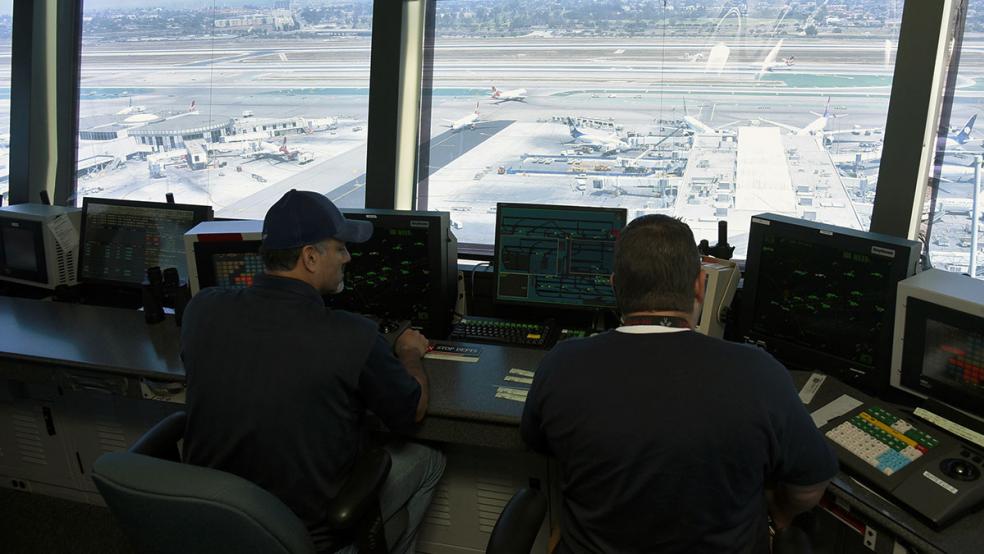Happy Infrastructure Week! I know, you’re still getting over the last Infrastructure Week three weeks ago. But the Trump administration has usurped the label, spotlighting its commitment to a bipartisan priority: rebuilding the nation’s critical needs. Unfortunately, everything you need to know about how team Trump views public policy can be seen in what it considers the perfect Infrastructure Week kick-off: privatizing the nation’s air traffic control system.
The plan did not originate with Trump. It actually comes from the airline industry, and its biggest champion in Congress, House Transportation Committee chair Bill Shuster, is literally sleeping with an airline industry lobbyist. It’s no worry because the lobbyist “doesn’t lobby my office,” Shuster reassured reporters in 2015. I would think she doesn’t need to.
So air traffic control privatization represents a rare instance where a policy idea is less tainted coming from Trump.
Related: Here's How Broken Washington Is — Even Without Trump
In a fact sheet, the administration lays out its air traffic control “reform” principles. It favors moving the system out of the Federal Aviation Administration (FAA) and into a non-profit, non-governmental entity. Over 30,000 federal employees would be spun off into this private company, with intact union membership and “similar” benefits and rights. The government would still regulate the system for safety purposes, and the private entity would still interact with military and homeland security agencies, and ensure open access to airspace.
At the heart of this is an assumption that U.S. air traffic control is inexorably backward, responsible for every fatal accident and excessive delay. But while the FAA does use radar instead of more modern GPS — it’s been working on changing that — this is mostly an exercise in blame-shifting.
The airline industry’s constantly broken computer systems, which are far more retrograde than anything air traffic control uses, are to blame for the lion’s share of all flight delays. I’ll grant that a GPS-based system would allow for quicker routes and lower fuel usage; that’s why Congress mandated the FAA to switch over. But it’s alarming that anyone would want to extend the industry’s spit-and-paper-clip approach to technology to the system that keeps airplanes from smacking into one another, especially when it would replace one of the world’s safest aviation programs.
Privatization would put the industry’s cost-cutters and jerry-riggers in charge. A 13-member board would control decision-making at the new non-profit. Airlines with over $10 billion in annual revenues would get twice as many seats on the board as general aviators, which make up 26 times as many planes in the air. The board would effectively control access to airports and gates, using safety as a lever to protect the Big Four carriers, which already control more than 80 percent of the routes.
Related: What’s Holding Back Private Infrastructure Investment in the US?
You can also see the influence of the airline industry in how the new system would be funded. Gone would be taxes on airline passengers. In their place would be fees on aircraft. Remember what I said about general aviation having 26 times as many aircraft as the big airlines? Plus, under the Trump plan, Congress or the courts would have no oversight over the user fee rates, giving this airline-dominated board near-total control over who pays.
The Big Four airlines have more ability to absorb these costs than start-up competitors or regional carriers that serve smaller cities. Lifting passenger fees would simply give the dominant carriers more legroom (unlike their passengers) to increase their own fees, either through higher fares or endless add-ons for another inch of space or a snack box or carry-on baggage or a pillow. Delta, actually an opponent of privatization, confirmed this in a study last year, showing that travelers would pay 20-29 percent higher costs if the U.S. shifted air traffic control from the FAA. And because of the Big Four’s extreme volume, they can pass on user fee costs in a way the competition cannot.
So to “modernize” the system, the government would further entrench a concentrated airline system, paid for by passengers. If we know anything from the past several years of air travel, we know that concentration has sacrificed customer service and quality for profits. This proposal would leverage the air traffic control system to ensure that this worsening of the flying experience remains dominant. And the airlines wouldn’t really pay anything to acquire this public asset, which serves the appropriately governmental function of keeping the skies safe.
Related: The Smartest Way to Finally Fix America’s Crumbling Infrastructure
Southwest Airlines CEO Gary Kelly admitted all this at a White House meeting in February, stating that the big problem with the system today is “we’re not in control. And I think that’s one of the things that we see as the path to having success.” Kelly called privatizing air traffic control “the single biggest opportunity for aviation.”
Privatization supporters insist that dozens of other countries, like Canada and the United Kingdom, have privatized their systems, enabling efficient modernization. These two countries in particular have needed to bail out the private corporations created, because the fee structure wasn’t viable. Indeed, the Congressional Budget Office confirmed a structural imbalance in last year’s version of air traffic control privatization. That’s before you get to the expected lawsuit against a private monopoly corporation collecting user fees outside of government control.
The only reason the Trump administration has jumped on this privatization plan, I gather, is because it fits so well with their infrastructure agenda. It’s really more of a fire sale, a chance for corporate interests to expand their dominion over the country by gobbling up common assets that taxpayers built.
Related: The More Trump Fails, the Better Off We’ll Be
Trump’s budget contains a net cut to infrastructure spending, despite lofty talk about fixing infrastructure. The budget would represent an all-out assault on an already-pathetic level of public investment. His team seems to be selling the myth that corporations will shoulder the burden out of the goodness of their heart.
In reality, private dollars will not solve our infrastructure problems without getting something in return. “Capital investment” might sound nice to people until they get hit with a toll on their road to work, or a giant spike in their water bill. It also means that anyplace too poor to afford those heavy tolls won’t get their infrastructure upgraded, a point even Republican senators concede.
All private infrastructure investment does is transfer the taxing function from the government to unaccountable corporations. And that would go double for the privatization of air traffic control.
If that sounds bad to you, then you’re not going to have much fun on this and future Infrastructure Weeks.






